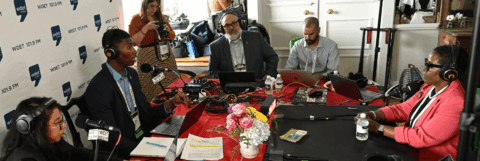- Data shows an increase in news deserts.
- Lack of support for local media threatens civic engagement and voter turnout.
- Innovative public policy, such as tax credits and fellowships, offer ways to strengthen local media.
- Federal budget cuts to local media disproportionately harm rural areas.
A thriving economy hinges on a healthy, stable democracy, and a significant part of that is credible, diverse, and well-resourced media to inform the citizenry.
On July 22, members of Michigan’s local media and the nationwide Local Media Association convened with business, community, and research leaders to discuss the importance of local journalism as a pillar of civic engagement and vital community service. Detroit Regional Chamber President and Chief Executive Officer Sandy K. Baruah delivered opening remarks.
“What’s happening in City Hall, the county courts, the state capital, and of course, in Washington must be reported on, not opinionated on,” Baruah said. “There’s certainly room for opinion, and there’s plenty of room for opinion in our social media feeds. But what is at risk is real news held to real journalistic standards.”
American journalist Chuck Todd also led a conversation with members of the Detroit Region’s local media about how this crisis is impacting them and their communities, and the importance of preserving this resource. Todd described the importance of local media well, as it garners more trust because communities can fact-check it every day when they walk out the door.
This issue is more important to the business community than many may realize. The Rescissions Act of 2025, which will make significant cuts to public media, is now expected to be signed into law, and experts expect it may negatively impact civic engagement and voter turnout.


